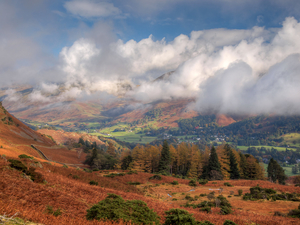n070

Coleridge is the friend here, and the passage—which Wordsworth has slightly revised—comes
from a notebook entry dated 5 January 1804.
These lines, drafted in late 1798, eventually became part of The Prelude (1850, V.384-88), but Wordsworth first published them under the title “There Was
a Boy” in the 1800 Lyrical Ballads.
The Eurasian widgeon is a common dabbling duck. It is unclear what bird Wordsworth
here calls the golding.
From Wordsworth’s “Water Fowl,” composed March 1800 but first published in Description of the Scenery of the Lakes (1823).
The Windermere island Wordsworth calls “Chapel-Holm” is more commonly known as Lady
Holme (i.e., “the island of Our Lady”) or St. Mary Holme, taking its name from the
chantry established there in medieval times. St. Herbert’s Island on Derwentwater
is named for the seventh-century anchorite who had his hermitage there. The island
became a place of pilgrimage by 1374, when the Bishop of Carlisle ordered the vicar
of Crosthwaite to celebrate mass there on the saint’s feast day and offered forty-day
indulgences to participants. See Wordsworth’s inscription poem “For the Spot Where
the Hermitage Stood on St. Herbert’s Island, Derwent-Water” (1800).
Milton, Paradise Lost, XI.835.
Derwentwater’s floating island has long been a curiosity, varying in size during its
different appearances. Early writers on the Lakes offered various ingenious speculations
on the science behind it. Wordsworth wrote about a “floating island” in the Prelude (1850, III.336–39), and Dorothy wrote a poem called “Floating Island” that appeared
in William’s volume of 1842.
Latin: a mystery or freak of nature.